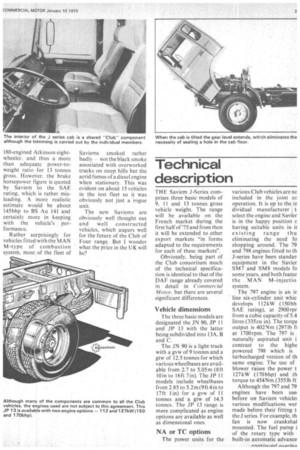First crack at the Club
Page 26

Page 27

If you've noticed an error in this article please click here to report it so we can fix it.
3aviern's lightweights prove worth savouring
)y Graham Montgomerie
viONDAY saw the official elease of the Saviem Club of our vehicle — the J-series. I vas able to drive two !xamples of the new range in nd around the mountains in he South of France -the IP Il at 11 tonnes gross and he JP 13C at 13 tonnes ross.
The start of the test was on twisting downhill section o the first half mile or so vas covered on the overrun, vly first impression of the iew baby Saviem was that he engine note suggested the xhaust brake was on "autopane" — obviously not the ase because no •exhaust irake was fitted. Once out on the autoroute it was a completely different story -the in-cab noise, or rather the lack of it, was very impressive indeed. At a comfortable cruising speed of around 80 km ill (50 mph) there was virtually no noise, neither engine, nor wind.
The acceleration of the JP 11 was adequate without being exceptional and the easy gearchange helped in this respect. The five-speed ZF box is standard throughout the Club of Four range and is already a well-proven component, but the gap between fourth and fifth proved slightly too wide, The MAN engine fitted to the J-series peaks at 2900rpm and even a very rapid change up to top could not prevent the revs falling to around 1800 rpm. This meant that on some of the longer gradients around Cannes the Saviem screamed away in fourth as it was unable to pull the top gear.
The brakes were good so far as retardation goes but they suffered from the usual air-over-hydraulic malady of a rather insensitive pedal. This is not so much of a problem in dry conditions but it can make driving on wet roads a rather dodgy proposition. On the twisty road test route the brakes stood up very well to some pretty hard use, but I still prefer a more sensitive means of operation.
Drivers should find the JP 11 comfortable. The cab was quiet and the vehicle ride was superb: cab visibility was good and the wiper pattern sensible. (One interesting point the Saviem front panel already has the location points for a right-hand-drive wiper pattern although no date has yet been officially suggested for the range's importation into the UK).
The second model.— the turbocharged 170 bhp JP 13C proved surprisingly different in character to the naturally aspirated Saviem. Gone was the "exhaust brake noise" but in its place was the typical whine of a turbocharged engine. However, this never became a serious nuisance.
With 170 bhp on tap this Saviem should theoretically have almost the equivalent power of, say, a Gardner I 80-engined Atkinson eightwheeler, and thus a more than adequate power-toweight ratio for 13 tonnes gross. However, the brake horsepower figure is quoted by Saviem to the SAE rating, which is rather misleading. A more realistic estimate would be about 145bhp to BS Au 141 and certainly more in keeping with the vehicles performance.
Rather surprisingly for vehicles fitted with the MAN M-type of combustion system, most of the fleet of Saviems smoked rather badly — not the black smoke associated with overworked trucks on steep hills but the acrid fumes of a diesel engine when stationary. This was evident on about 15 vehicles in the test fleet so it was obviously not just a rogue unit.
The new Saviems are obviously well thought out and well constructed vehicles, which augurs well for the future of the Club of Four range. But I wonder what the price in the UK will be?




































































































